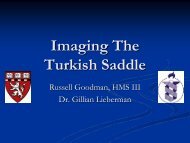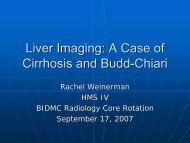The Basics of MRI: T1 vs. T2
The Basics of MRI: T1 vs. T2
The Basics of MRI: T1 vs. T2
Create successful ePaper yourself
Turn your PDF publications into a flip-book with our unique Google optimized e-Paper software.
Frank Minja, HMS III<br />
Gillian Lieberman, MD<br />
<strong>T1</strong> Weighting<br />
• Different tissues have different <strong>T1</strong> and <strong>T2</strong> time constants<br />
• Table <strong>of</strong> <strong>T1</strong> and <strong>T2</strong> constants<br />
• To obtain an <strong>MRI</strong> image the voxel <strong>of</strong> interest must be pulsed several<br />
times with RF.<br />
• <strong>The</strong> time in between RF pulses is the repetition time (TR).<br />
• If the repetition time is long enough, all spinning protons will re-align<br />
themselves with the vertical axis = no contrast<br />
• If the repetition time is short, some spinning protons will re-align faster<br />
than others = Bingo! contrast!<br />
• <strong>T1</strong> relaxation<br />
• 90 degree RF pulse followed by a <strong>T1</strong> signal<br />
• Thus, <strong>T1</strong> weighting = short TR (repetition time)<br />
11
















